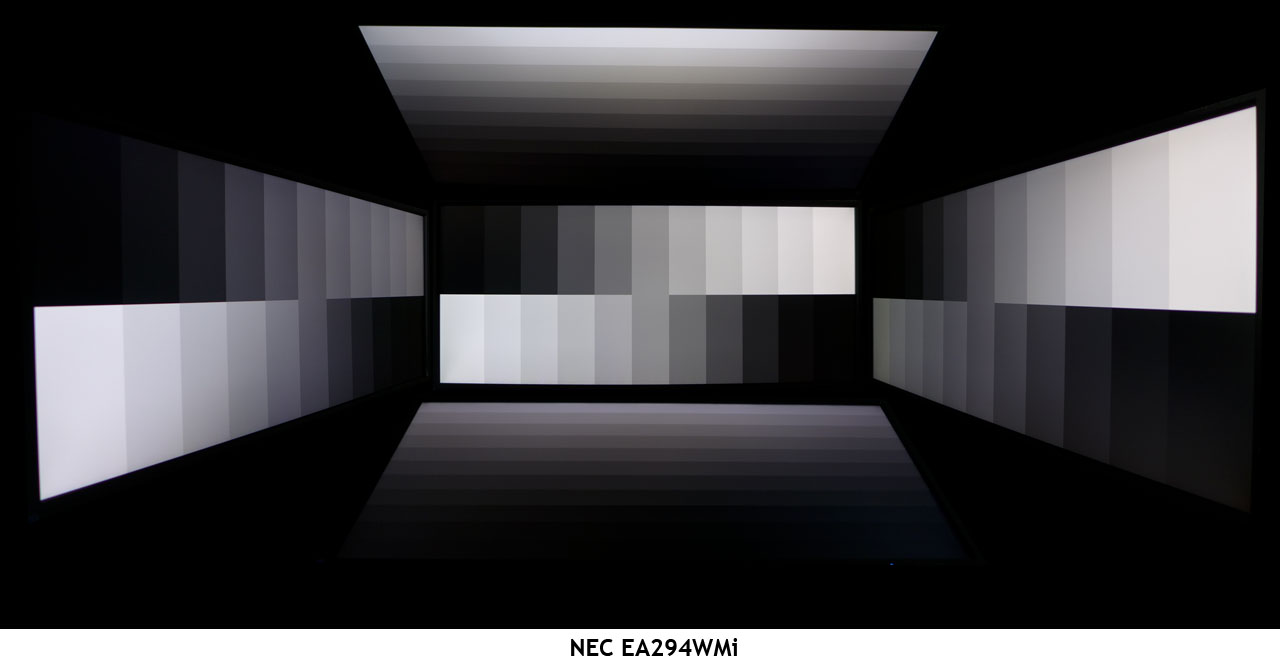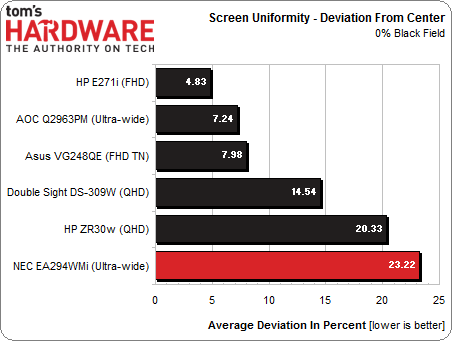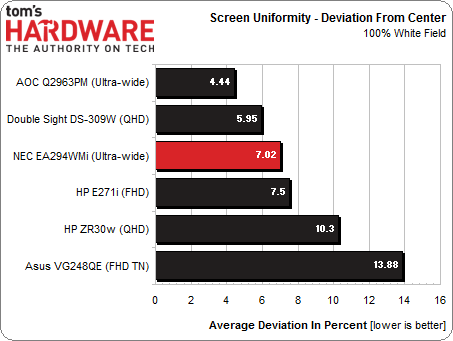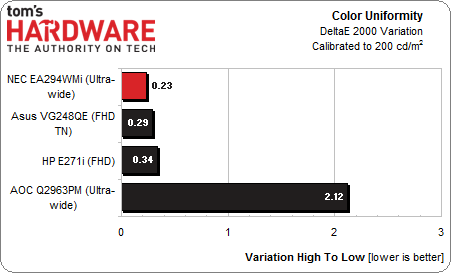NEC EA294WMi 29" Monitor Review: 21:9 At Twice The Price
Last month, we reviewed AOC’s Q2963PM ultra-wide monitor at 2560x1080. Based on the same LG panel, NEC brings us its EA294WMi. Selling for almost twice as much, does this screen offer two times the performance and features? Our tests give you the answer.
Results: Viewing Angle And Uniformity
We saw some interesting results in this test from AOC's Q2963PM. Because of the extreme width of these screens, there is a greater possibility of color shift and brightness falloff when viewed more than 45 degrees off-center.
Like the AOC, we see a slight blue shift in the top and bottom photos, along with a fair amount of light falloff. All of the bars are still visible, which is a good thing. Side to side performance is very good, with no color shift and very little light falloff. IPS technology consistently sets the bar for LCD viewing angles. And it continues to improve.
To measure screen uniformity, zero percent and 100 percent full-field patterns are used, and nine points are sampled. In a change from previous reviews, we’re now comparing the results to other monitors we’ve measured. First, we establish a baseline measurement at the center of each screen. Then the surrounding eight points are measured and their values expressed as a percentage of the baseline, either above or below. This number gets averaged. It is important to remember that we only get to test one review unit, and other samples of the same monitor can measure differently in this metric.
First up is black field uniformity.
The upper-right and lower third of the screen really hurts the EA294WMi. These areas are visibly brighter than the center portion. As always, your mileage may vary.
Here’s the white field measurement.
The 100 percent white field looks great, with no areas visibly brighter or darker than the center region. We also looked at other brightness levels and found no visible issues until we got down to 20 percent.
Get Tom's Hardware's best news and in-depth reviews, straight to your inbox.
Screen Uniformity: Color
Starting with our review of AOC's Q2963PM, we’re adding a new uniformity test to our benchmark suite: color. The above measurements only address luminance. Now, we’re measuring the white balance variation in an 80-percent white field pattern. The results are expressed as a variation in Delta E (or in other words, the difference between the highest and lowest value).
The EA294WMi comes out on top in this benchmark, yielding an excellent performance. LCD panels have come a long way in the last few years as far as color uniformity goes. Not long ago, it was normal for a screen to show visible color tints in different parts of a white field. Now, it’s much more rare. This monitor fares well and is unlikely to be eclipsed any time soon.
Current page: Results: Viewing Angle And Uniformity
Prev Page Results: Color Gamut And Performance Next Page Results: Pixel Response And Input Lag
Christian Eberle is a Contributing Editor for Tom's Hardware US. He's a veteran reviewer of A/V equipment, specializing in monitors. Christian began his obsession with tech when he built his first PC in 1991, a 286 running DOS 3.0 at a blazing 12MHz. In 2006, he undertook training from the Imaging Science Foundation in video calibration and testing and thus started a passion for precise imaging that persists to this day. He is also a professional musician with a degree from the New England Conservatory as a classical bassoonist which he used to good effect as a performer with the West Point Army Band from 1987 to 2013. He enjoys watching movies and listening to high-end audio in his custom-built home theater and can be seen riding trails near his home on a race-ready ICE VTX recumbent trike. Christian enjoys the endless summer in Florida where he lives with his wife and Chihuahua and plays with orchestras around the state.
-
runswindows95 Considering this screen is $805 for this monitor on Newegg, I rather get a nice 2560X1440, like the Dell U2713, for the money, or dual 1920X1200 screens. 2560X1080 really isn't an ideal resolution for any practical application.Reply -
TBC1 Reply11821147 said:Triple Post! Triple Post! Triple Post! But yeah too much money
Darn thing lagged on me!
-
Vorador2 Well this is a professional monitor so the high price is not that surprising. Still if i were on the hunt for a monitor this wouldn't be my choice.Reply -
burkhartmj You could get 2 Dell Ultrasharp U2412M's plus a dual monitor mount for the price of this, it just doesn't make sense at this price point.Reply
There's also the issue of ultra wide screen. This seems to have a niche market that doesn't exist, a professional grade monitor that's only particularly good at watching movies. People who just watch TV and movies all day aren't going to be willing to spend more than 250 on a monitor , and those who want/need professional features will want as much screen real estate as possible, opting for large 16:9 or 16:10 monitors.
This is exacerbated by the fact that this aspect ratio is literally ONLY helpful for movies, not even TV. having big black bars on each side during a TV show or older movie that doesn't have the cinematic aspect ratio is way more distracting than the thin bars at the top and bottom created by cinematic movies on normal 16:9/10 monitors. -
jasonpwns I dislike this new trend. I'd rather have a 27 inch with 2560x1440. Why are we constantly trying to lower our screen resolutions. This 1080p trend needs to stop.Reply -
InvalidError Reply
I would prefer 2560x1600 on a 24" screen myself.11822582 said:This 1080p trend needs to stop.
The problem is the bulk of offer and demand gravitates around 1920x1080 since that is what most common forms of entertainment are optimized for. With 1080p screens starting as low as $90, anything higher than that for 3-5X the price becomes a tough sale so these higher-resolution monitors get pitched and priced as "professional" displays instead of trying to compete for people's desktops.
I paid $270 for my 24" 1200p display four years ago. Equivalent models today are usually listed around $400. To me, this seems to indicate that mainstream interest in higher resolution desktop displays has regressed, hence the switch to pitching those nearly exclusively at professionals and enthusiasts. -
mortsmi7 Seems to me that if your a fan of the 4:3 ratio, and want a seamless dual monitor experience, this might be the way to go. For once, a person might have reasonable room to put two windows side by side. And it sure as hell takes up less desk space than two separate monitors.Reply



